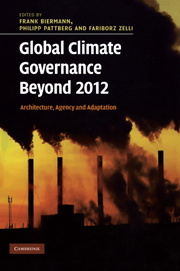Book contents
- Frontmatter
- Contents
- List of contributors
- Preface
- List of abbreviations
- 1 Global climate governance beyond 2012
- Part I Architecture
- 2 The architecture of global climate governance
- 3 The consequences of a fragmented climate governance architecture
- 4 Environmental effectiveness and economic consequences of fragmented versus universal regimes
- 5 Developing the international carbon market beyond 2012
- 6 The overlap between the UN climate regime and the World Trade Organization
- 7 An architecture for long-term climate change
- 8 Shaping the architecture of future climate governance
- Part II Agency
- Part III Adaptation
- Index
- References
5 - Developing the international carbon market beyond 2012
options and the costs of delay
Published online by Cambridge University Press: 05 July 2014
- Frontmatter
- Contents
- List of contributors
- Preface
- List of abbreviations
- 1 Global climate governance beyond 2012
- Part I Architecture
- 2 The architecture of global climate governance
- 3 The consequences of a fragmented climate governance architecture
- 4 Environmental effectiveness and economic consequences of fragmented versus universal regimes
- 5 Developing the international carbon market beyond 2012
- 6 The overlap between the UN climate regime and the World Trade Organization
- 7 An architecture for long-term climate change
- 8 Shaping the architecture of future climate governance
- Part II Agency
- Part III Adaptation
- Index
- References
Summary
Introduction
Emission trading has become one of the most important policy instruments for controlling greenhouse gas emissions. The Kyoto Protocol introduced an intergovernmental emissions trading system that runs from 2008 to 2012 and in which countries accepted economy-wide caps and the possibility to trade so-called Assigned Amount Units. Participation of developing countries is possible through the Clean Development Mechanism (CDM) (Stripple and Lövbrand, this volume, Chapter 11). With its International Transaction Log the climate secretariat provides the institutional infrastructure for these trading mechanisms. Complementing the Kyoto trading system, the European Union has established a company-level EU emissions trading scheme in 2005, with its second trading period running in parallel to the Kyoto system (van Asselt 2010). The EU emissions trading scheme regulates about 10 000 facilities that currently emit around 2 gigatonnes carbon dioxide per year (Skjærseth and Wettestad 2008).
In addition to these developments, an increasing number of industrialized countries are implementing or planning to set up national cap-and-trade systems, including Australia, New Zealand, the United States, Canada and Japan. On the sub-national level, the Regional Greenhouse Gas Initiative, the Western Climate Initiative and the Midwestern Greenhouse Gas Accord have emerged in the United States, while the Japanese provinces of Kyoto and Tokyo consider the introduction of regional emissions trading. In 2007, several of these national and sub-national initiatives and the European Union inaugurated the International Carbon Action Partnership with the explicit aim of exploring options for linking the domestic trading systems in the broader perspective of creating a global carbon market (Bergfelder 2008).
- Type
- Chapter
- Information
- Global Climate Governance Beyond 2012Architecture, Agency and Adaptation, pp. 60 - 78Publisher: Cambridge University PressPrint publication year: 2010



